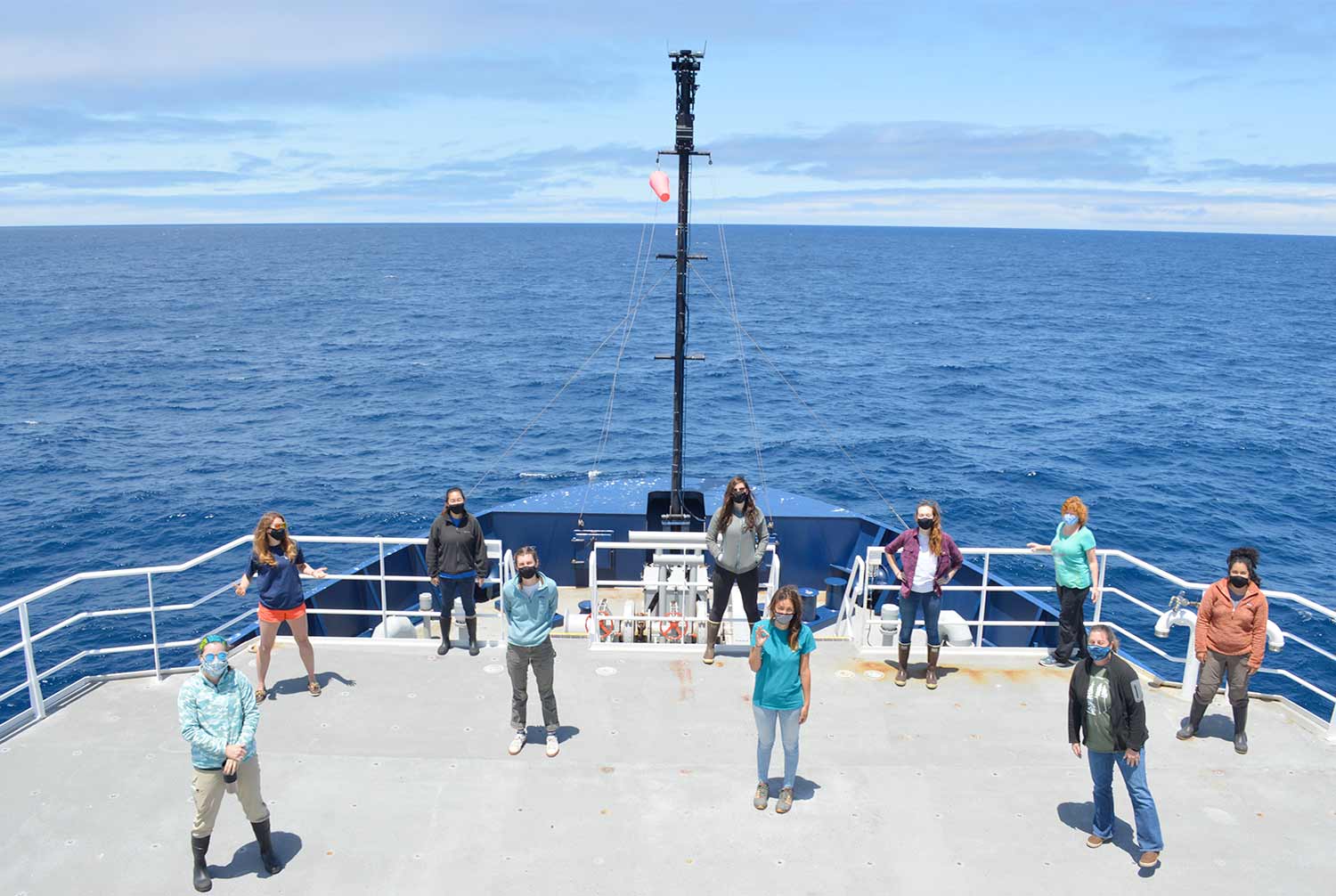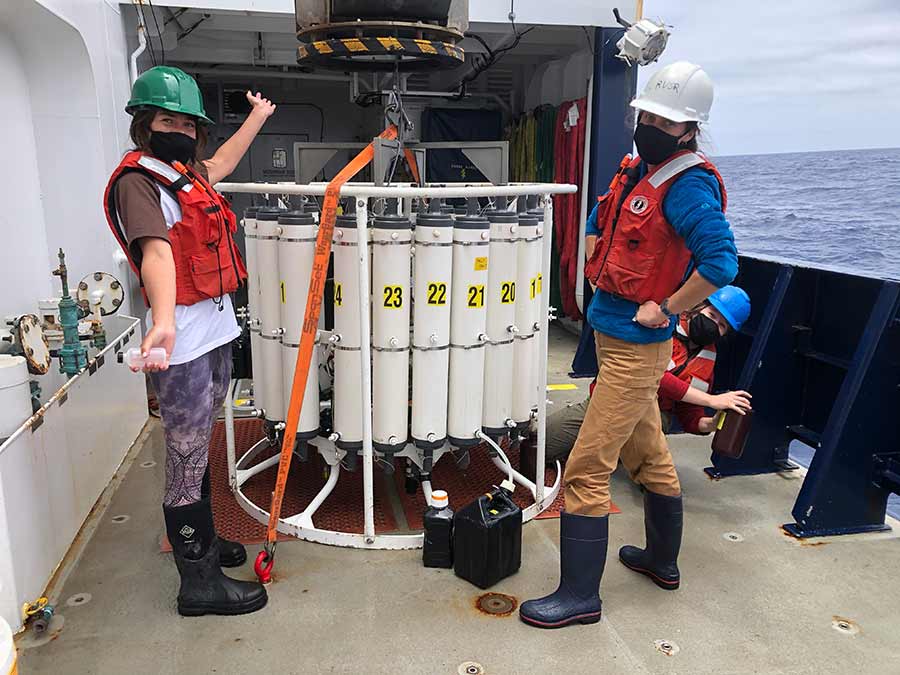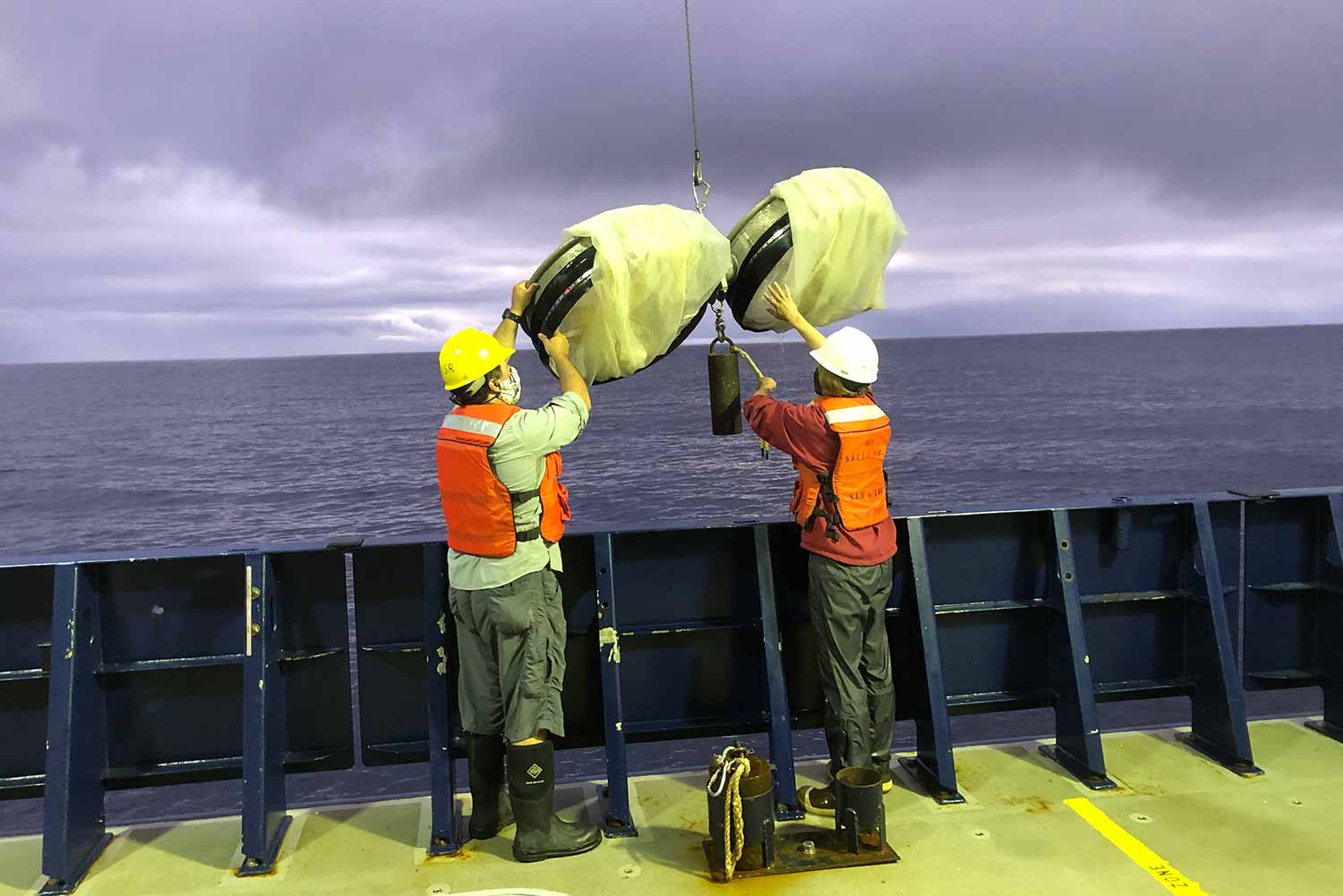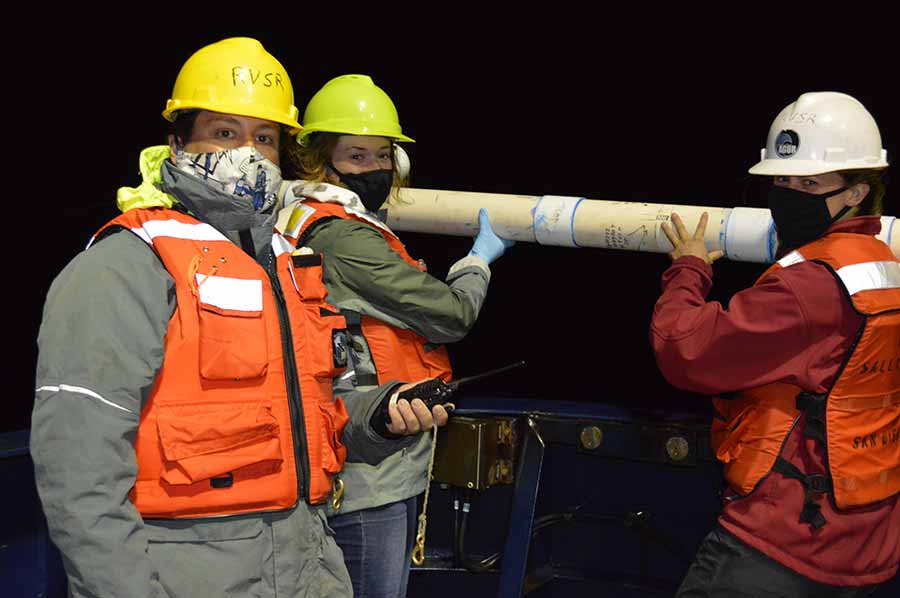By:
- Laura Lilly
- Angela Klemmedson
Published Date
By:
- Laura Lilly
- Angela Klemmedson
Share This:

The science party aboard R/V Sally Ride. Laura Lilly is at far left at rear; Angela Klemmedson is fourth from right.
All-Female Science Party Aboard R/V Sally Ride Continues 71-year CalCOFI Measurement Series
Researchers honor pioneering astronaut and legacy of iconic science program
Many women of our generation entering careers in marine science take for granted that we will be given the same opportunities and respect as men receive. Less than a decade before most of us were born, astronaut Sally Ride made history as the first American woman ever to go to space. Her journey, however, was often plagued by questions and doubts of whether women possessed sufficient physical and mental abilities to function in a challenging space environment and “man’s world” of technical science.
Thirty years after Ride’s historic 1983 trip to space, the U.S. Navy commissioned a new oceanographic research vessel to be operated by Scripps Institution of Oceanography at UC San Diego through the University-National Oceanographic Laboratory System (UNOLS). The Navy named the vessel R/V Sally Ride, which is one of only two UNOLS ships ever to have been named after a woman. And in July 2020, the 71-year-old California Cooperative Oceanic Fisheries Investigations (CalCOFI) program accomplished a historic event of its own, setting sail with its first-ever all-female science party—fittingly aboard R/V Sally Ride.

From left, Scripps technician Kelsey Vogel, Scripps student Anne Schulberg and University of San Diego student Grace Cawley (ducking behind) with a CTD rosette.
We, Laura Lilly and Angela Klemmedson, are two of the ten scientists who participated in this historic cruise. Laura is a Ph.D. candidate in the Ohman Lab at Scripps Oceanography, and Angela is an oceanographer with CalCOFI, in the Integrated Oceanographic Division.
The CalCOFI program was initiated in 1949 as a joint effort between Scripps, NOAA and the California Department of Fish and Wildlife. Its initial purpose was to investigate the collapse of the California sardine fishery that took place earlier that decade, which delivered a significant economic blow to several coastal California communities. Since its inception, the program’s growing time series has provided insights into seasonal, interannual and long-term fluctuations in the California Current System’s water masses, nutrient concentrations, planktonic and larval fish communities, and seabird and marine mammal populations.
CalCOFI measurements are used to validate regional ocean circulation models and fisheries predictions. It is also a long-term context for other monitoring programs such as the California Underwater Glider Network (CUGN) and the California Current Ecosystem Long-Term Ecological Research site (CCE-LTER).
The CalCOFI program usually conducts four research expeditions per year off southern and central California. Due to the COVID-19 pandemic, the spring 2020 cruise was canceled—the first time in more than 30 years that a CalCOFI cruise did not sail. Skipping one cruise in a 71-year time series may not seem like a big deal, but even one missed season means lost knowledge about rapidly evolving, potentially novel conditions in our system.
Within the last decade, we have seen unprecedented physical and biological changes in the California Current, including the 2014-15 “Blob,” a large mass of warm surface waters off the West Coast that negatively impacted everything from phytoplankton to sea lions—followed immediately by the 2015-16 El Niño, shorter-term marine heat waves in the summers of 2018 and 2019, and northward extensions of pelagic red crabs and pyrosomes to Northern California and Oregon. CalCOFI has provided important—and sometimes the first—measurements of these evolving events, particularly of planktonic and larval fish communities. Spring 2020 passed under our hull unsampled; therefore, we needed to get out this summer to begin measuring again.
Despite our determination, the Summer 2020 CalCOFI cruise almost didn’t happen. By June, UNOLS and Scripps had developed a COVID-19 plan to restart San Diego-based research cruises. Unfortunately, rigorous self-isolation protocols and lack of work clearance meant many CalCOFI scientists could not join the summer cruise; we needed 10 people to conduct the essential CalCOFI components. With a bit of scraping and pleading, we pulled together just enough. Some were experienced CalCOFI technicians, while others were graduate students and volunteers who had never sailed with the program.

Scripps Oceanography marine technician Jeremiah Brower (left) and Laura Lilly deploy a bongo net used to collect plankton.
After several last-minute personnel changes, CalCOFI technician Angela Klemmedson stepped in as chief scientist. When she reviewed the seagoing personnel list, she realized that every scientist sailing with her was a woman! One asset of CalCOFI is that many of its seagoing personnel have developed decades of hands-on knowledge about their sampling instruments. The new COVID-19 restrictions—including a six-day hotel isolation and three swab tests before boarding the ship—meant non-sailing technicians could not come to the dock to set up equipment. Subsequently, our setup and training involved online protocols, pre-cruise socially-distanced walkthroughs of plankton net deployments, and multi-hour Zoom sessions to set up a finicky nutrient autoanalyzer, which we needed to measure nitrate, phosphate, and silicate levels in the seawater samples we collected.
We had a sense of underlying panic going into loading: “What are we forgetting? How does Dave usually set this up?” (For the past several decades, every CalCOFI cruise has had at least one “Dave,” notably Dave Wolgast, Dave Griffith, and Dave Faber, former longtime CalCOFI research scientists.) But we put our critical thinking skills to work on each obstacle, and soon our floating lab was ready to sail.
We kept the momentum going all cruise, successfully sampling all 75 summer CalCOFI stations, from the Scripps Pier to four hundred miles offshore, up to Avila Beach, and back down through the Channel Islands. We had to eliminate several standard sampling processes, including plankton nets that target surface zooplanktonic communities and fish eggs, and seabird and marine mammal observations. We retained the core suite of CalCOFI measurements, though: hydrographic sampling (using an oceanographic instrument called a “CTD-Rosette” that measures Conductivity, Temperature, and Depth, among several other parameters, and also collects water samples), Bongo and PRPOOS (short for: Planktonic Rate Processes in Oligotrophic Ocean Systems) nets to capture and quantify zooplankton communities, nutrient analyses, genomics, measurements of seawater pH and dissolved CO2to determine the ocean’s acidity, and underway samples of the near-surface phytoplankton community. We also launched four miniature wave buoys for Scripps oceanographer Eric Terrill’s research group, and a radio buoy constructed by the Mount Carmel High School Radio Club.

From left to right, Scripps Oceanography marine technician Jeremiah Brower, Angela Klemmedson and Laura Lilly deploy a radio buoy for the Mount Carmel High School Radio Club.
So how did the California Current System look this summer, and how is life at sea under quarantine? On the oceanographic side, our nearshore plankton nets came back onboard “green” with a heavy phytoplankton coating. Perhaps not coincidentally, we observed high abundances of pyrosomes across the region. Pyrosomes look like long, squishy, pink tubes and are colonial zooplankton, meaning each “tube” is actually a bunch of genetically identical animals that create a home structure through which they pump seawater to filter phytoplankton. At night, pyrosomes floating at the ocean’s surface sometimes flash blue with bioluminescence, hence their name (“pyrosome” is Greek for “fire-body”). Pyrosomes are somewhat mysterious because we still can’t predict when and why they will bloom, but they have appeared more frequently and abundantly off the West Coast in the past five years than in the past several decades. Most of the pyrosomes we captured were still in the young stage (“tetrazooids”), but a few Bongo tows came back laden with adults.
Only time—and continued sampling of the California Current this fall—will tell whether the young pyrosomes again explode into an expansive region-wide population. And it turns out that life at sea is still a blast under quarantine measures, even when everyone is wearing masks, eating meals in 15-minute small-group rotations, and eliminating “science huddles” in the main lab. We used social distancing as an excuse to eat many lunches and dinners on the back deck, and we even hosted a cribbage tournament (with proper social distancing and sanitizing measures).
In addition to our all-female science party, our ship’s crew had growing female representation: the third mate, bosun, and two able-bodied crewmembers (ABs) were women. We are grateful to ALL the women and men of the crew for helping us conduct precise and high-quality scientific sampling to maintain the valuable CalCOFI time series, and to Scripps Ship Operations and Marine Technical Support (SOMTS) for developing a rigorous safety plan that allowed us to sail despite COVID-19 challenges. We will continue to work on diversity in the oceanographic community until people of all genders, races, and backgrounds feel welcome and equal at sea and in science.
Laura Lilly is a Ph.D. candidate at Scripps Oceanography and Angela Klemmedson is a CalCOFI technician at Scripps.
Share This:
You May Also Like
Stay in the Know
Keep up with all the latest from UC San Diego. Subscribe to the newsletter today.



